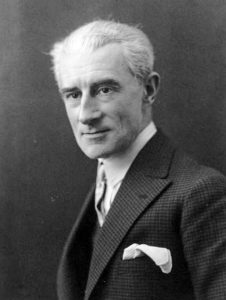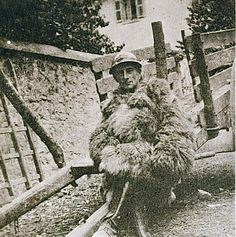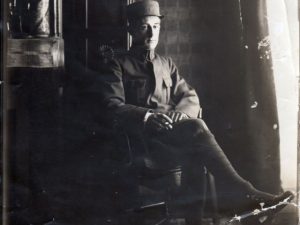Ravel’s lessons for young composers
If you follow me on Facebook or Twitter, you probably noticed that I was obsessed with Maurice Ravel over the summer, posting several quotes and anecdotes. Time to explain that a little bit. In June, on a whim, I picked up Arbie Orenstein’s Ravel: Man and Musician (Columbia University Press 1975; Dover 1991) off my bookshelf—I had owned the book since high school, but never read it cover-to-cover.
In reading Orenstein’s text, I revisited one of my earliest musical loves. The first CD I ever purchased was an album of Ravel’s orchestra music. As a piano student I played Menuet Antique, Sonatine, and Jeux d’eau. Martha Argerich’s recording of Gaspard de la nuit absolutely blew my mind; the climax of the first movement (Ondine) still escapes my understanding—how does Ravel create that depth of sound with each hand playing only one note at a time? In high school, my youth orchestra performed La Valse, and as the orchestra’s pianist, I spent rehearsals on the sidelines following with the score.
Orenstein’s book is part biography, part reference (with an encyclopedia-style entry on each Ravel composition), and part composition lesson. My favorite chapters are those devoted to Ravel’s aesthetics, language, and creative process (ch. 7-9). Here we find a wealth of insight into Ravel’s musical mind through his students, to whom he was an avid mentor and pedagogue, and also from a stunning lecture that Ravel delivered at Rice University in April 1928, during his one and only North American tour. The full text of this lecture (in English) is available here in PDF.
I find several episodes from Ravel’s life to be absolutely instructive for today’s composers, and have selected three of these points below. To be clear, these “lessons” (as I call them) are not Ravel’s literal words, but my own extrapolations from studying his life and works. (All page numbers in this post refer to Orenstein.)

Maurice Ravel, 1925 (source)
1. Be patient through adversity. Are you a young composer struggling to gain ground? You know your own creative worth, but it hasn’t been recognized yet? Well, Ravel is in your corner.
Born in 1875, Ravel entered the Paris Conservatoire in 1889, initially as a piano student. His scholastic years were troubled. In 1895, Ravel was expelled from his harmony class after failing to win a single harmony prize in a three-year period. Worse, in July 1900, Ravel was expelled from his composition class (!) for failing to win a prize in fugue during a two-year period. He continued on as an auditor until 1903, when he was officially expelled from the Conservatoire after the first movement of his String Quartet failed to capture a composition prize.
While Ravel enjoyed the warm support and mentorship of Gabriel Fauré, it was obvious “that a considerable amount of friction existed between Ravel and Théodore Dubois, who became director of the Conservatoire…in 1896” (26). Even in his student years, Ravel already cultivated aspects of his mature style: polytonality, modality and whole-tone passages, split chords, polychords, diminished octaves, ostinati, unresolved seventh and ninth chords, unresolved appoggiaturas. Saint-Saëns declared his Jeux d’eau (1901) to be “total cacophony,” a pronouncement that led Ravel to believe “that his chances of any future academic success were now virtually nil” (36).
The cards were stacked against him, but Ravel soldiered on. He competed for the hallowed Prix de Rome five times (1900, 1901, 1902, 1903, and 1905), but never won; his best finish was third place in 1901. Dubois and Saint-Saëns sat on the nine-member jury. In an attempt to please the judges, Ravel intentionally subjugated his more forward-looking style elements for these competitions, but the musical results were not convincing (nor were they truly Ravel).
By 1905, his last year of eligibility, a few of Ravel’s works (Jeux d’eau, String Quartet) had entered the standard repertory. When he was eliminated from the Prix de Rome in the first round, scandal broke out. To be fair, Ravel had probably given up hope by this point; his choral submission contained seven consecutive measures of parallel octaves, and his fugue concluded with a blatant major seventh chord, which was “corrected” by a member of the jury. All six finalists that year were students of a single Conservatoire professor, Charles Lenepveu, who was conveniently allowed to serve on the jury. Lenepveu vehemently maintained his innocence. All the same, the Conservatoire’s curriculum and practices came under scrutiny; Dubois resigned as director and was replaced by Fauré (44).
What can we learn from this? Ravel’s early struggles were about environment. But he believed in the value of his musical accomplishments and continued to produce high-quality music outside of the auspices of the vaunted Prix de Rome competition. He did not allow the totality of his work and development to be subsumed by the prevailing establishment at the time. In the end, it was probably better for Ravel not to win and thereby become his own artist.
Lessons for young composers: don’t get too discouraged by rejection. Don’t focus all your effort on pleasing a single perspective or point of view. Engage in a broad range of projects that strengthen your skills. Always place a premium on improving the quality of your writing, and never dampen your originality to placate others. It may take years, but quality work will ultimately show itself and earn the respect it deserves.
2. How to get better at stuff (even out of school). Today we consider Ravel to be one of the greatest orchestrators of the 20th century. What amazes me, however, is that Ravel cited his own weak orchestration as the main reason for his defeat in the 1901 Prix de Rome. He considered his orchestral writing to be too hasty and uneven. So how did Ravel progress from his 1901 disappointment to such celebrated orchestral essays as Rapsodie espagnol (1907-08), Mother Goose (1911), and Daphnis et Chloé (1909-12), all within the span of a decade? Recall that Ravel was no longer a full-time student during this period.
Orenstein explains: “Ravel’s orchestral technique was the fruit of long years of study, incessant questioning of performers, much experimentation, and innumerable rehearsals” (136-7). He read treatises by Berlioz, Rimsky-Korsakov, and Widor (Technique de l’orchestre moderne, 1904). He pored over the scores of Rimsky-Korsakov and Richard Strauss, especially Don Juan and Till Eulenspiegel; Ravel’s copy of Don Juan had been so thoroughly handled that the pages’ edges had blackened. He developed his own approach, always starting with the string section, treating each section of the orchestra as a “choir.”
“As a creative artist, Ravel was keenly aware of his weaknesses and strengths” (139). Using the available resources, revering composers and works stylistically disparate from his own, Ravel greatly expanded his knowledge and skill without a regular teacher. He came into full maturity after his stormy student days had passed.
Lessons for young composers: assess your weaknesses frankly. Plot out concrete steps to improve them, and start immediately; don’t wait for a teacher or professor to assign you the work. Take steps every day to get better. Be disciplined and don’t rely on an outside schedule or structure to guide you. Study the repertoire and literature in vigorous detail. Explore the resources available to you, and not just online stuff: fellow musicians, local concerts and cultural institutions, public and school libraries.

Ravel the soldier, 1916 (Source)
3. Be a good colleague. I’ll close with two episodes from Ravel’s life that describe his approach to the other major composers of his time. First, Debussy. Orenstein notes that the personal relationship between Ravel and Debussy was often “strained” (67), but in 1913, Ravel paid Debussy a serious favor. Unbeknownst to each other, both composers began working on three settings of poems by Stephane Mallarmé, and two of the selected poems were exactly the same: “Soupir” and “Placet futile.” Ravel finished first and easily obtained copyright permission from Mallarmé’s son-in-law. When Debussy completed his version and requested permission, the son-in-law refused, saying that Ravel had already set the poems. Ravel pleaded Debussy’s case with the son-in-law, who eventually granted permission to the older composer.
A few years later, during World War I, a large group of prominent French musicians formed the National League for the Defense of French Music, which “proposed to ban all music by German and Austrian composers whose works were not yet in the public domain” (73). Ravel, who served the war effort as a truck driver (a highly perilous role that frequently placed him near the front lines at Verdun), refused to join the League. (Check out this great BBC feature on Ravel’s war years, which includes his military photograph.) In a letter dated June 7, 1916, Ravel clarified his objections to the League:
“It would even be dangerous for French composers to ignore systematically the productions of their foreign colleagues, and thus form themselves into a sort of national coterie: our musical art which is so rich at the present time, would soon degenerate, becoming isolated by its academic formulas.
“It is of little importance to me that M. Schoenberg, for example, is of Austrian nationality. This does not prevent him from being a very fine musician, whose very interesting discoveries have had a beneficial influence on certain allied composers, and even our own. Moreover, I am delighted that MM. Bartók, Kodály and their disciples are Hungarian, and show it so unmistakably in their music” (74).

Ravel, March 1916 (Source)
Ravel mentions Schoenberg again in his 1928 Rice lecture, claiming that Schoenberg had influenced him as an artist, but not as a serialist. (He lists the Chansons madécasses as an example.) For Ravel, these were two separate things: a composer’s tools and techniques on one hand, and a composer’s artistic sensibility on the other. You could be inspired by one of the two, by both, or by neither. Artistic expression was to be lauded, regardless of differences of style.
Lessons for young composers: support your fellow composers. There is room for everybody. Gain as much as you can from other composers’ discoveries and techniques. Try to distinguish compositional technique from artistic sensibility in the manner that Ravel suggests. Don’t make snap judgments or slap artificial labels on others’ work. Listen to something new each day.
copyright 2017 Edward (Teddy) Niedermaier; no reproduction without permission
(please contact me if interested in reproduction or redistribution)